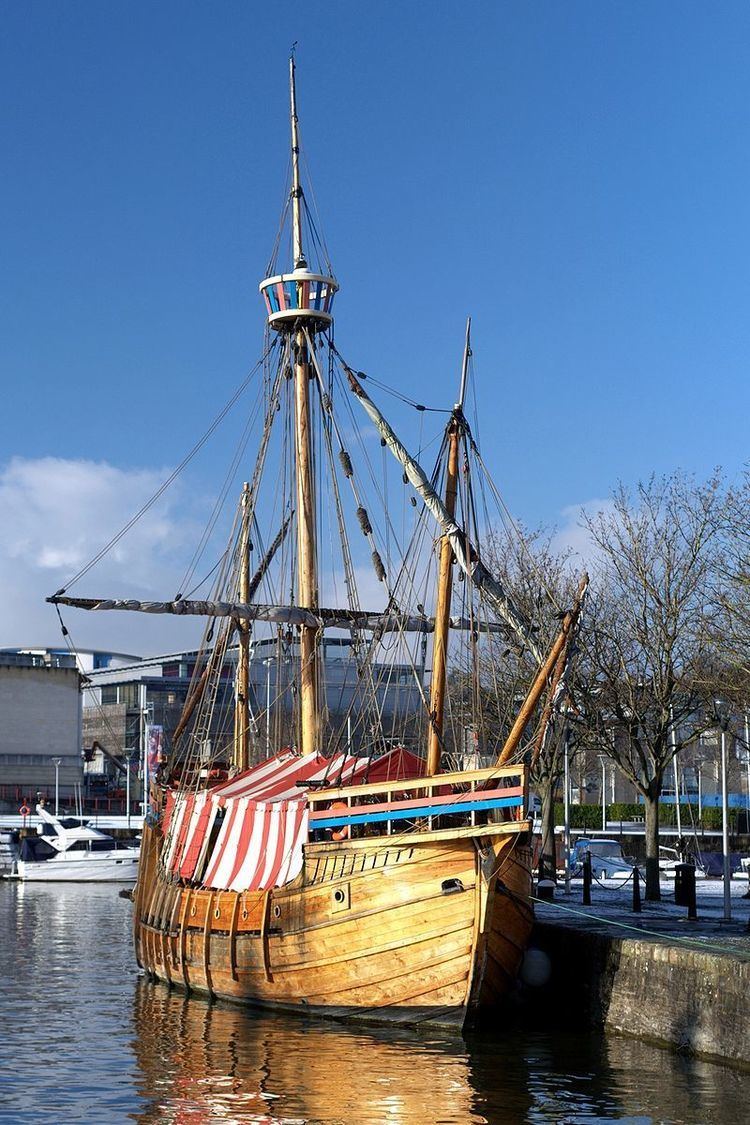Name The Matthew Laid down 1994 Type replica caravel Construction started 1994 Weight 0.0386 tons | Builder Storms'l Services Homeport Bristol Displacement 85 Launched 1996 | |
 | ||
Address Princes Wharf, Wapping Road, Bristol BS1 4RN, United Kingdom Hours Open today · 10AM–4PMWednesday10AM–4PMThursday10AM–4PMFriday10AM–4PMSaturday10AM–4PMSunday10AM–4PMMondayClosedTuesday10AM–4PM Similar Bristol Harbour, SS Great Britain, M Shed, Cabot Tower - Bristol, Brandon Hill - Bristol Profiles | ||
The Matthew is a replica of a caravel sailed by John Cabot in 1497 from Bristol to North America, presumably Newfoundland. After a voyage which had got no further than Iceland, Cabot left again with only one vessel, the Matthew, a small ship (50 tons), but fast and able. The crew consisted of only 18 people. The Matthew departed either 2 May or 20 May 1497. He sailed to Dursey Head (latitude 51°36N), Ireland, from where he sailed due west, expecting to reach Asia. However, landfall was reached in North America on 24 June 1497. His precise landing-place is a matter of much controversy, with Cape Bonavista or St. John's in Newfoundland the most likely sites.
Contents
Cabot went ashore to take possession of the land, and explored the coast for some time, probably departing on 20 July. On the homeward voyage his sailors incorrectly thought they were going too far north, so Cabot sailed a more southerly course, reaching Brittany instead of England. On 6 August he arrived back in Bristol.
History
Lack of clear documentation has been a problem in studying the history of Matthew. Even its name has been questioned, with some authors suggesting that it was actually named Mattea after Cabot's wife. Until the 1950s, all that was known about its size is that it was a small ship carrying about 18 men, but the discovery of a letter from a Bristol merchant named John Day written in 1497 saying that "in his voyage he had only one ship of fifty 'toneles' and twenty men and food for seven or eight months" provided more certainty about its size. The age of the ship is also uncertain. The name Matthew does not appear in the 1492/3 customs accounts, so it was either fairly new or an older ship renamed or a foreign ship. It has been suggested that it probably was an ordinary Bristol merchant ship hired for the occasion. The name Matthew appears in documents in 1503/04 and 1510/11 but in a 1513 survey there is reference to a 'new Matthew' and references to this ship afterward leave out the 'new' suggesting that Cabot's Matthew no longer existed.
Replica
To celebrate the 500th anniversary of Cabot's voyage, a replica of Matthew was built in Bristol by Storms'l Services, a precursor of the Bristol Classic Boat Company. The design was by naval architect Colin Mudie. She was dedicated in a ceremony during the first International Festival of the Sea, held in Bristol's Floating Harbour in 1996. The next year, she reconstructed Cabot's original journey on the 500th anniversary of the landmark voyage. On 24 June 1997 the replica of Matthew was welcomed into port at Bonavista by Queen Elizabeth II.
The full-size replica is 78 ft (24 m) in length overall with a beam of 20 ft 6 in (6.25 m) with a draft of 7 ft (2.1 m) and 2,360 sq ft (219 m2) of sail.
On 29 February 2012 Matthew's ownership was transferred to The Matthew of Bristol Trust, and she was relocated to her new home outside Bristol's M Shed museum.
In June 2012 she took part in the Queen's Diamond Jubilee pageant on the River Thames.
